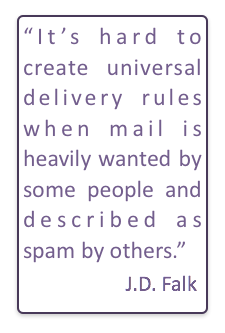Politics and Delivery
Last week I posted some deliverability advice for the DNC based on their acquisition of President Obama’s 2012 campaign database. Paul asked a question on that post that I think is worth some attention.
I am fascinated by the ramifications of email deliverability for political donations.
Are there sysadmins at the big ISPs who make human decisions on deliverability issues anymore? The power they have to make one candidate’s mail get delivered over another candidate’s mail is enormous. Paul Rydell
There are a lot of issues inside his questions, all of which deserve some discussion.
The first is who makes deliverability decisions inside ISPs. My experience is that it isn’t really sysadmins who do that. Even in the early days (late 90s) most of the delivery decisions were made by someone other than the sysadmins, at least at the big consumer ISPs. In the early 2000s most blocking decisions were handled by humans, making decisions based on data from their internal tools. As the tools became better, the decisions were handled automatically. By the mid to late 2000s, many systems were handling blocks and bans without a human having to review and allow them.
I don’t believe at most of the consumer ISPs and webmail providers that there is any single person with the authority to block mail. There are multiple people who are permitted to block mail that meets the criteria for blocking. But, those criteria are based on performance, not based on message. I’ve written about this many times before. (The Perils of Politics, Censorship, Email and Politics, They’re not blocking you because they hate you, It really can be your email, More on Truthout, Another perspective on the politico article).
There’s also an implication that one person “a sysadmin” shouldn’t have the ability to make decisions about what traffic is OK and what traffic isn’t. Except that’s exactly how it is. Sysadmins have a lot of access to our private data. Some of them can even read our email. Many sysadmins, particularly those who herd large numbers of machines, are very careful about respecting recipient needs, wants and privacy. I was once working with a friend who was a sysadmin at supernews to try and troubleshoot some USENET problems I was having. He made very sure to get direct permission from me to actually look at my account and log information.
Do I think every sysadmin is a bastion of integrity? Of course not. No group of people is perfect all the time. But I do think those individuals who have the power to block messages “follow the rules” when making blocking decisions. Those rules are written by the ISP management team, and people who block traffic have to answer to their manager (and manager’s manager) when they violate the internal processes and block things for reasons that are not behavior based. Everyone who has the power to block mail has a management chain that enforces behavior based blocking.
Then there’s the complexity of what a sysadmin is and what their job is. I asked Mary, who was a sysadmin at a giant consumer ISP in the late 90s, to talk about her experiences as a sysadmin and blocking issues.
Finally, there’s an implication that ISPs have a responsibility to accept and deliver every piece of email sent to them. It’s been established case law, for almost 20 years now, that ISPs do not have to accept and deliver every piece of mail (Cyberpromo v. AOL). If recipients are complaining about mail, there is no obligation for the ISP to deliver it.
Now, Paul and I have had these discussions before. We’ve worked together to address deliverability challenges for political mailers. Some of that work inspired some of my earlier posts on political mail and blocking. A lot of people really believe that email is a public channel, after all most of the public can use it. But it’s not a public channel. Most of the internet, in fact, is privately owned. The owners have a lot of authority to only allow certain traffic on their networks, and blocking email is in that realm of authority.
